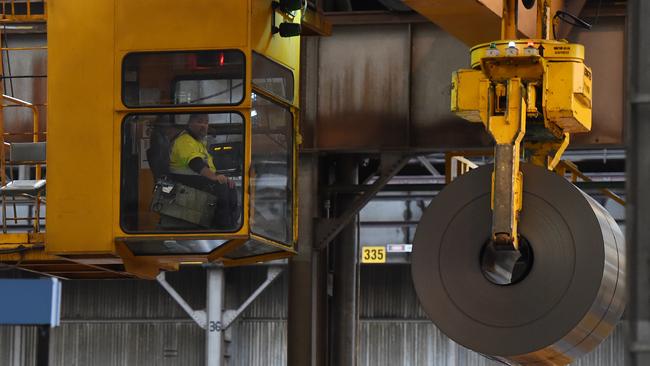
The mechanism applies to the 215 industrial facilities that each emit more than 100,000 tonnes of greenhouse gas a year. Those facilities – which account for 28 per cent of Australia’s emissions – will be required to reduce their emissions by 4.9 per cent each year to 2030, relative to a baseline that takes account of their individual characteristics.
The problem is that producers of goods such as steel and cement cannot meet that target using currently available technologies. It is true that firms will be able to purchase credits that allow them to emit more than the set level; but the cost of those credits will undermine their competitiveness, making it possible for rivals – from countries such as Indonesia, India or China – to erode their market share.
Initially, the government expects to deal with that by moderating the targets it imposes on facilities directly exposed to import competition. However, industry groups, including the Business Council of Australia and the Australian Industry Group, have recommended introducing a Carbon Border Adjustment Mechanism, along the lines of the one the EU will implement in 2026. The mechanism would tax imports whose estimated carbon “footprint” exceeds the baseline that applies to domestic producers of the goods with which they compete. The imports would, to that extent, be treated as if they had been produced locally and had been obliged to buy Australian carbon credits.
According to the industry groups, this kind of local treatment would address the issue of “carbon leakage” – that is, of reductions in Australian emissions being offset by greater emissions elsewhere – in an economically efficient manner.
But it is not obvious that the claim is correct. In effect, even if all countries faced equally stringent emissions-reduction targets, there would be some redistribution of production, depending on the relative costs of abatement.
It may be, for example, that Indonesia could meet its emissions reduction goal at lowest cost by drastically scaling back logging, thus leaving room for activities such as cement production to grow; conversely, Australia, lacking those low-cost abatement opportunities, might have to let cement production shrink for its targets to be met. Under those circumstances, given that difference in abatement costs, it is desirable for Indonesia to specialise in and export cement, even if its cement is “dirtier” than Australia’s.
In reality, countries don’t face equally stringent emissions-reductions targets. Rather, the targets developing countries have accepted are substantially less stringent than those Australia is imposing on itself. But that isn’t an accident: it is a design feature of the international agreements every Australian government has – rightly or wrongly – endorsed as a way of “equitably sharing” the global abatement burden.
As a result, far from being an unexpected consequence of the current arrangements, a redistribution of emissions from developed to developing countries is an integral element in their design. And its natural outcome is that emissions-intensive activities will expand in poorer countries and contract in their richer counterparts.
It is of course possible, indeed certain, that the prevailing international allocation of emissions reduction targets is not ideal: an alternative distribution could achieve the objective at materially lower cost, for instance by ensuring that abatement occurs wherever it is cheapest.
But it is dangerous to assume that imposing the Australian carbon price on imported goods would necessarily move us towards that optimal distribution. If the prevailing global allocations are truly arbitrary, modifying the trade flows they generate by an Australian carbon tax is unlikely to make them less so.
The risk of compounding inefficiencies is even greater if the proposed border adjustment mechanism taxes imports whose carbon intensity is above our baseline but does not issue tradeable credits to those which fall below it. In that event, imports would not in fact be treated equivalently to domestic production, distorting the allocation of resources and potentially breaching our obligations in respect of international trade.
In practice, those concerns are unlikely to have much impact. Instead, the pressures to protect local manufacturing seem set to result in a muddle of measures that subsidise massively with one hand what the other hand has heavily taxed – as is occurring in the EU.
The issues might have been easier to deal with if an entirely different approach, analogous to the Goods and Services Tax, had been adopted. In that approach, which Geoff Carmody, a prominent Australian economist, advocated long ago, it is not the production of emissions but the consumption of the goods that embody them which would have been taxed.
As with the GST, exports would be exempted; a uniform carbon price would be applied to all domestic sales, both locally produced and imported, thus treating them equally.
In addition to greater neutrality, taxing consumption seems to better highlight the trade-offs we are being asked to make. After all, we measure our standard of living in terms of how much we consume, rather than how much we produce; and it is how much consumption we have to forgo that best measures the sacrifices we are willing to accept for the sake of reducing emissions.
The “Carmody tax” has plenty of serious problems. Its overwhelming merit, however, is that it makes the consumption sacrifice transparent – which may be one reason it has never been adopted. Every household would know how heavily it was being taxed on each outlay, rather than having that amount buried in hidden imposts on production. And knowing how much they were paying, consumers might legitimately ask whether the benefits of the policy exceeded its costs.
That depends on whether our sacrifices are likely to materially reduce global emissions; and if so, whether they will avert changes in the global climate whose costs exceed the costs that have been incurred to avoid them.
On that score, the government has startlingly little to say: in more than 100 pages of carefully crafted documentation, there is no indication of the percentage reduction in global emissions that the measures will secure or of that reduction’s effect on the likelihood of global warming.
There is, nonetheless, some good news. The government’s package involves no fewer than 17 interrelated programs, each with myriad sub-programs. Even better, there is a “New Energy Skills” stream, which will lavishly fund “upskilling”: perhaps the workers in cement and steel can be retrained to manage the torrents of public spending.
And there is light at the end of the tunnel for the rest of us too: trainload upon trainload of new public servants, coming the other way.






As the government itself recognises, some industries will struggle to meet the emissions-reduction targets set down in its new “safeguard mechanism”. The question being debated is how their difficulties should be addressed.